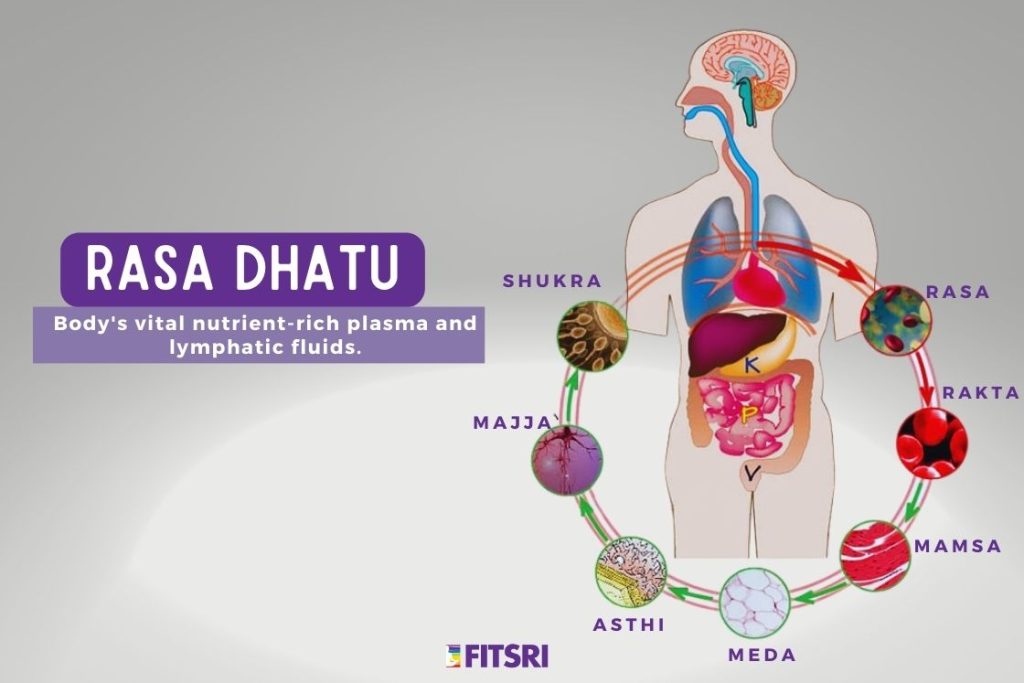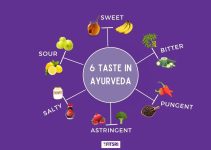
Ayurveda is based on the principle of balance, and the Dhatus are its pillars. Dhatus are the main tissues of the body that provide physiological processes, growth, protection and vitality.
Seven dhatus appear in the Ayurvedic framework:
Rasa, the nutrient plasma.
Rakta, the life-giving blood.
Mamsa, the muscles that give shape.
Meda, the fat that isolates.
Asthi, the bones that grant structure.
Majja, the marrow that fills the bone cavities.
Shukra, the reproductive tissue, which is important for reproduction.
Understanding these Dhatus is crucial. An imbalance in any one Dhatu can disrupt the harmony of the body. When they are in balance, they provide health and vitality; an imbalance can lead to disease. In Ayurveda, practitioners recognise dhatu imbalances and guide therapies to restore balance. In essence, Ayurveda’s success in holistic healing is tied to the nuanced understanding and maintenance of these Dhatus.
Rasa Dhatu According to Charaka Samhita and Sushruta Samhita
Charaka Samhita on Rasa Dhatu
- Nature of Rasa: Charaka Samhita defines Rasa as the essence of digested food. Once food is consumed and processed by the body’s Agni (digestive fire), the first and most refined essence that is formed is Rasa Dhatu.
- Function: Rasa nourishes the body, providing strength, complexion, and Ojas (vital essence). It’s compared to the water that nourishes a plant, allowing it to flourish.
- Qualities: The text describes Rasa Dhatu as having attributes similar to Kapha dosha – it is cool, heavy, and unctuous.
- Disorders: Imbalances in Rasa Dhatu can lead to diseases like fever, thirst, and anorexia. Charaka also describes the causes of its imbalance, such as inappropriate diet and poor digestion.
Sushruta Samhita on Rasa Dhatu
- Formation: Sushruta Samhita emphasizes the process of digestion, where food is subjected to various stages of transformation. The initial and prime essence that emerges after the first phase is Rasa.
- Circulation: Once formed, Rasa is circulated throughout the body via channels called Srotas. This process ensures that all cells and tissues receive the necessary nourishment.
- Importance in Surgery: Given Sushruta’s surgical expertise, there’s a mention of the need to assess the quality of Rasa Dhatu before surgical procedures. A balanced Rasa indicates a better prognosis and quicker recovery.
- Detrimental Practices: Consuming food without understanding one’s Prakriti (constitution) or indulging in excessive physical activity can vitiate Rasa Dhatu, leading to various ailments.
Exploring the Rasa Dhatu in Detail
Rasa Dhatu, a central concept in Ayurveda, encapsulates the essence of nutrition and sustenance. Directly translating from Sanskrit, “Rasa” means “essence” or “juice.” It denotes the vital fluid or plasma that circulates within our body.
Rasa Dhatu originates from the food we consume, undergoing intricate transformation processes in the digestive tract. After digestion, the extracted nutrients form the foundational Rasa Dhatu, which then circulates throughout the body. It’s a fundamental entity, paving the way for the formation of other Dhatus and maintains fluid balance
In its purest form, Rasa Dhatu provides vitality, strength and enthusiasm. It is the foundation upon which the body’s nutrition and immunity stand. Understanding its importance is crucial to a holistic understanding of Ayurvedic principles and the interplay of the body’s function.
How Rasa is formed from the food we eat?
The formation of rasa dhatu begins with digestion. When food enters the stomach, digestive enzymes act on it and break it down into various components.
This broken down food, known as “Ahara Rasa”,” is further refined in the small intestine. Here, digestive juices and enzymatic processes extract the finer essence of the food. This essence, rich in nutrients, forms the preliminary Rasa Dhatu.
Once formed, Rasa Dhatu is transported to every part of the body through channels called “srotas.” As it circulates, it provides essential nutrients and ensures that each cell receives sufficient nourishment for its functions.
It’s a continuous process. Every meal we eat contributes to the formation and replenishment of Rasa Dhatu. This is the reason why Ayurveda emphasises a balanced and healthy diet. The quality of our food has a direct influence on the quality of Rasa Dhatu and thus on our overall health.
Rasa Dhatu embodies the nutritive journey from the food on our plate to the vital force circulating within us, underscoring the profound link between our diet and well-being.
Importance of Rasa Dhatu in Context of Overall Health and Vitality
Rasa Dhatu is an essential component of general health. As the main source of nourishment, it provides energy to every cell and maintains vitality.
As the first dhatu in the sequence, Rasa Dhatu forms the basis for subsequent dhatus. A disturbance in its quality can have a cascading effect on other tissues.
It’s critical for hydration. By maintaining fluid balance, Rasa Dhatu ensures smooth cellular functioning and metabolic processes. Adequate hydration optimizes energy levels and cognitive function.
In addition to nutrition, Rasa Dhatu plays a central role in immunity. It’s the first line of defense against external pathogens and ensures that the body remains robust and resilient. It also supports the removal of cellular waste and effectively detoxifies the body systems.
It also has a subtle connection to our emotional well-being. An imbalance in Rasa can lead to feelings of dissatisfaction or lack of joy. Therefore, its balance is important not only for physical health, but also for mental tranquility.
The health of Rasa Dhatu is a reflection of our overall well-being. Prioritizing its balance isn’t just essential for physiological health; it’s foundational for holistic vitality. Ensuring its quality and equilibrium, thus, becomes paramount.
Understanding Rasa Dhatu in Context of Modern Science
In modern science, Rasa Dhatu parallels the body’s plasma – the yellowish fluid in blood. Plasma carries cells, proteins, hormones, and nutrients to various body parts.
The nutritive role of Rasa Dhatu is comparable to that of plasma, which transports essential substances such as glucose, amino acids, and fatty acids that are essential for cellular energy and function.
Its immune function can be compared to the albumin and globulins of plasma. Albumin balances fluid balance; globulins fight infections, reminiscent of the protective role of rasa in Ayurveda.
In addition, the detoxification attributed to Rasa Dhatu mirrors the waste transport mechanism of plasma. Plasma transports waste to the excretory organs, ensuring a toxin-free system.
When Rasa Dhatu is viewed through the lens of modern science, its significance becomes even clearer. It bridges ancient wisdom and contemporary knowledge and affirms the timeless relevance of Ayurvedic principles.
10 Quick Tips to Maintain Healthy Rasa Dhatu
The health of Rasa Dhatu directly influences our overall well-being. Ensuring its balance is key to vitality. Here are ten actionable tips to maintain its equilibrium:
- Wholesome Diet: Opt for fresh, organic foods. Include grains, vegetables, and milk in daily meals.
- Hydration: Drink sufficient water daily. Herbal teas, like fennel and coriander, aid in balancing Rasa.
- Avoid Processed Foods: Minimize consumption of preservatives, additives, and processed sugars, which disrupt Rasa Dhatu.
- Regular Detox: Practice fasting or Ayurvedic cleansing rituals periodically to rid the body of toxins.
- Yoga Postures: Include poses like Child’s Pose (Balasana) and Cobra Pose (Bhujangasana) to stimulate and balance Rasa Dhatu.
- Herbal Support: Consider Ayurvedic herbs like Shatavari and Licorice. They rejuvenate and fortify Rasa Dhatu.
- Manage Stress: Embrace techniques like meditation or deep-breathing exercises, which preserve Rasa’s integrity.
- Consistent Sleep Pattern: Ensure 7-8 hours of restful sleep. Rasa Dhatu rejuvenates during rest.
- Limit Stimulants: Reduce intake of caffeine and alcohol, which can dehydrate and imbalance Rasa.
- Regular Massage: Opt for self-massages using sesame oil. It invigorates and nourishes Rasa.
By incorporating these tips, one can ensure the optimal health of Rasa Dhatu, laying the foundation for comprehensive wellness.
Conclusion | Relation Between Yoga and Rasa Dhatu
Yoga and Ayurveda are deeply rooted. Both strive for holistic well-being, with yoga aiming at physical and mental harmony and Ayurveda at physical balance. Their convergence becomes clear when one examines the Rasa Dhatu.
Rasa Dhatu, the essence of our digested food, fuels our bodies. An imbalance can lead to a number of problems. Yoga with its various asanas and pranayama supports digestion and ensures efficient formation of rasa.
Certain yoga postures stimulate the digestive system. Postures such as Pawanmuktasana and Paschimottanasana encourage digestive fire. This ensures that food is processed appropriately, resulting in quality Rasa Dhatu.
Pranayama, the art of controlled breathing, also plays a role. Techniques such as kapalbhati invigorate the digestive tract. Such practices ensure that the food we eat is effectively converted into Rasa.
To conclude, yoga ensures optimal digestion, indirectly fostering the balance of Rasa Dhatu. As practitioners, recognizing this link can amplify our wellness journey. By integrating yoga, we not only benefit our mind and physique but also ensure the nourishment and vitality driven by a balanced Rasa Dhatu. Thus, yoga emerges as a key ally in Ayurvedic well-being.




 Oct 24th to 30th
Oct 24th to 30th Learn Mudras
Learn Mudras  Deepen Your Practice
Deepen Your Practice  Find Inner Peace
Find Inner Peace